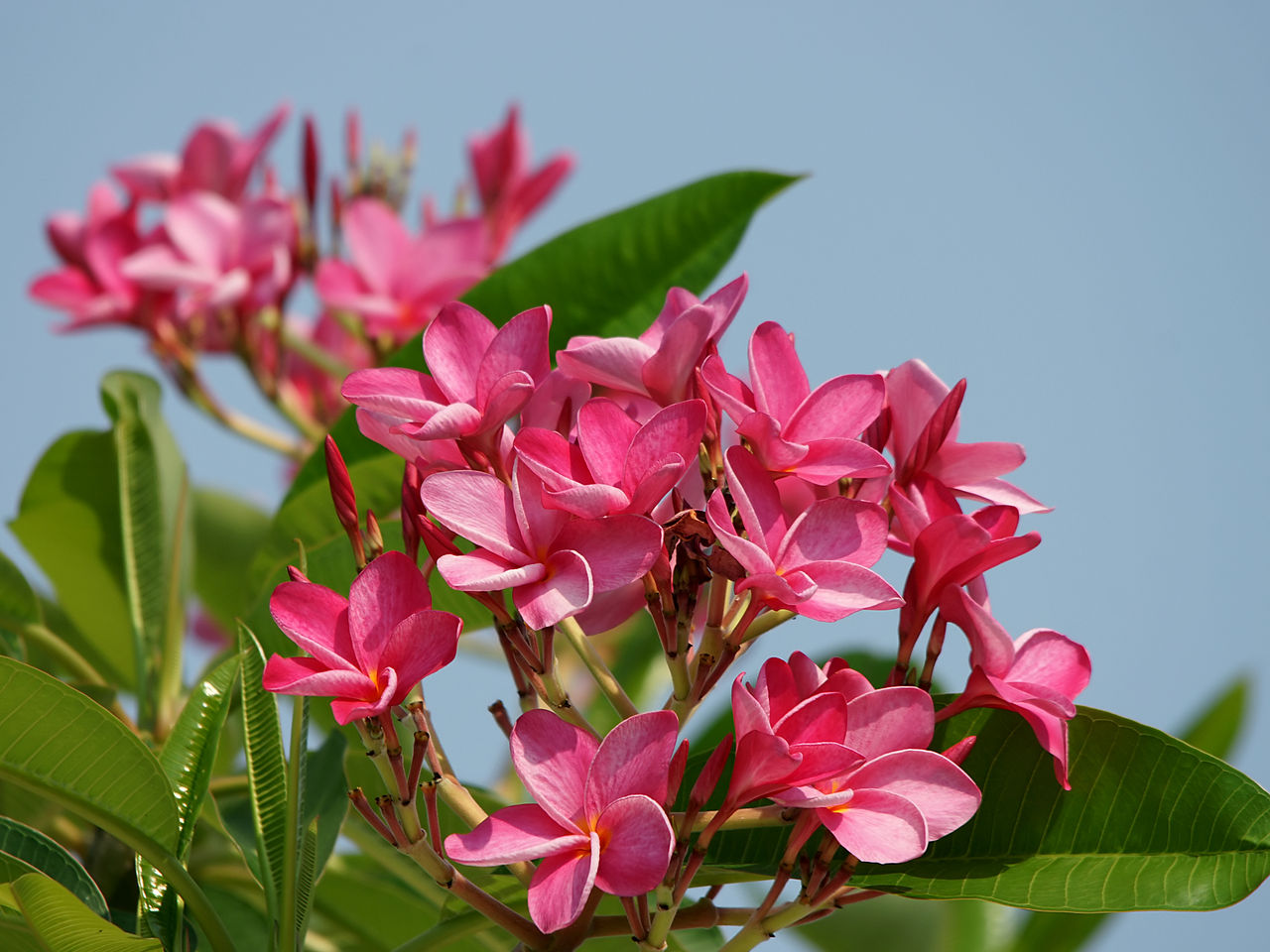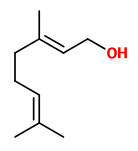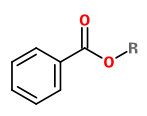Plumeria rubra L. - syn.Plumeria acuminata W. T. Aiton - Apocynaceae
frangipani, pagoda tree, red jasmine, Frangipani
Spreading shrub or small tree, 2-8 m high, native to southern Mexico and Central America, cultivated in tropical and subtropical regions as an ornamental plant; flowers highly fragrant, red, pink, or white with shades of yellow in the centre.
Plumeria tricolor Ruiz & Pav. = Plumeria rubra forma tricolor
Plumeria acutifolia Poir. = Plumeria rubra forma acutifolia
http://www.ars-grin.gov/cgi-bin/npgs/html/taxon.pl?28884
„In Mexico the common name is Cacaloxochitl or Suchitl. The name comes from nahualt and means Crow's flower. The common name in Australia is 'frangipani', although 'plumeria' is used in the United States. Other common names are 'red frangipani', 'common frangipani', 'temple tree', or simply 'plumeria'. The term melia is a Hawaiian one. The common name 'frangipani' comes from an Italian noble family, a sixteenth-century marquess of which invented a plumeria-scented perfume.“
http://en.wikipedia.org/wiki/Plumeria_rubra
„Known from early Spanish records of Aztec plants, Plumeria rubra L. has been spread across the tropical and subtropical worlds as a landscape tree. Early use in cemeteries led to its being called a graveyard flower, and the fragrant, colorful, waxy blooms were offered to the gods and the departed. In Hawaii, the flowers are strung to make a floral necklace, or lei, and the tree has become an important crop with over 14 million blooms sold for lei in 2005.“
http://www.actahort.org/members/showpdf?booknrarnr=813_23
„The leaves are usually glossy green but may be dull green; they are generally ovate, may be blunt-tipped
(P.obtusa) or pointed (P. rubra var.acuminataor var.acutifolia), and range from 2 to 4 inches wide and 8 to 12 inches long. In deciduous types, the leaves fall during wintertime, and new leaves emerge during or following the spring flowering period. P. obtusa and its hybrids tend to retain their foliage year-round. The flowers are tubular, expanding into a “pinwheel” of five petals that averages 2-3 inches diameter and may be white, red, yellow, pink, or multiple colors. Flowers of most cultivars are highly fragrant and bloom from March to October.
The hybrids differ in their profusion of blooms, with some producing more than 200 flowers per cluster and others only 50-60 flowers.“
[Ornamentals and Flowers OF-24: Plumeria. Criley, Richard A (February 1998). Cooperative Extension Service, C/T/A/H/R. Department of Horticulture, College of Tropical Agriculture & Human Resources, University of hawaii at Manoa]
http://www.ctahr.hawaii.edu/oc/freepubs/pdf/OF-24.pdf
„The essential oil of Plumeria rubra forma acutifolia (Poir.) Woodson cv. ‘Common Yellow’ growing in Hawaii was extracted by simultaneous distillation and extraction (SDE). The essential oil was analysed with GC and GC-MS, and a total of 74 compounds were identified. Linalool, phenylacetaldehyde, trans,trans-farnesol, β-phenylethyl alcohol, geraniol, α-terpineol, neral and geranial were found to make a major contribution to the floral scent of this flower.“
[Volatile components of plumeria flowers. part 1. Plumeria rubra forma Acutifolia (poir.) woodson cv.‘common yellow’. Omata, Akihiki, et al., Flavour and fragrance journal Vol.6 (4), 1991, 277-279]
„The essential oil of one of the cultivars of Plumeria rubra L. ‘Irma Bryan’ growing in Hawaii was extracted by simultaneous distillation and extraction (SDE). The essential oil was analysed with GC and GC-MS, and a total of 67 compounds were identified. β-Phenylethyl alcohol, phenylacetaldehyde and methyl cinnamate were found to make a major contribution to the floral spicy scent of this flower.“
[Volatile components of plumeria flowers. Part 2.1 Plumeria rubra L. cv.‘Irma Bryan’. Omata, Akihiko, et al., Flavour and fragrance journal Vol.7 (1), 1992, 33-35]
„The volatile oil was obtained by steam-distillation… main constituents of the volatile oil of acutifolia Bailey were β-linalool (20.67%), cis-geraniol (16.19%) and trans-nerolidol (14.06%).“
[The Constituents of Volatile Oil from Plumeria rubra L. var. acutifolia Bailey., Huang, Mei-yan, et al., Journal of Anhui Traditional Chinese Medical College, 4 (2005), 18]
Frangipani flowers give off their fragarance early in the morning and at dusk, which is reminescent of rose, citrus, and cinnamon, with jasmine, coconut and fruity undertones. Concrete and absolute from the flowers made with 1,1,1,2-tetrafluorethane and ethanol had similarly strong and characteristic odors, strikingly close to that of the living flower. Non-volatiles such as triterpenols (amyrin, amyrin acetate), hydrocarbons (nonacosene), plumericin and isoplumericin, α-tocopherol (0.4%), phenylethyl salicylate, and (E,E)-farnesol made up the greatest part of the absolute oil. Main constituents of the volatile fraction were 2-phenylethanol, linalool, methyl benzoate, geraniol, α-terpineol, and benzyl cyanide, in decreasing concentrations. The distribution of these compounds was similar to that extract of the pomade, obtained by traditional enfleurage of the flowers over 3 days.
[Joulain, Daniel. „Flower scents from the Pacific.“ Chemistry & biodiversity 5.6 (2008): 896-909]
„Plumeria rubra is one such plant that has been frequently used as medicine which belongs to Plumeria genus. The decoction of the bark and roots of P.rubra used to treat asthma, ease constipation, promote menstruation, venerial disease, reduces fever and latex used to soothe irritation. The plant contains various phytoconstituents like the cytotoxic iridoids, fulvoplumerin, oleanane type triterpene etc.“
http://www.ijptjournal.com/File_Folder/116-119.pdf

Trew, C.J., Ehret, G.D., Plantae selectae, vol. 5: t. 41 (1755) [G.D. Ehret]
http://plantillustrations.org/species.php?id_species=813040

Plumeria rubra flowers; Hans Hillewaert (2011) Wikimedia Commons, © CC BY-SA 3.0





